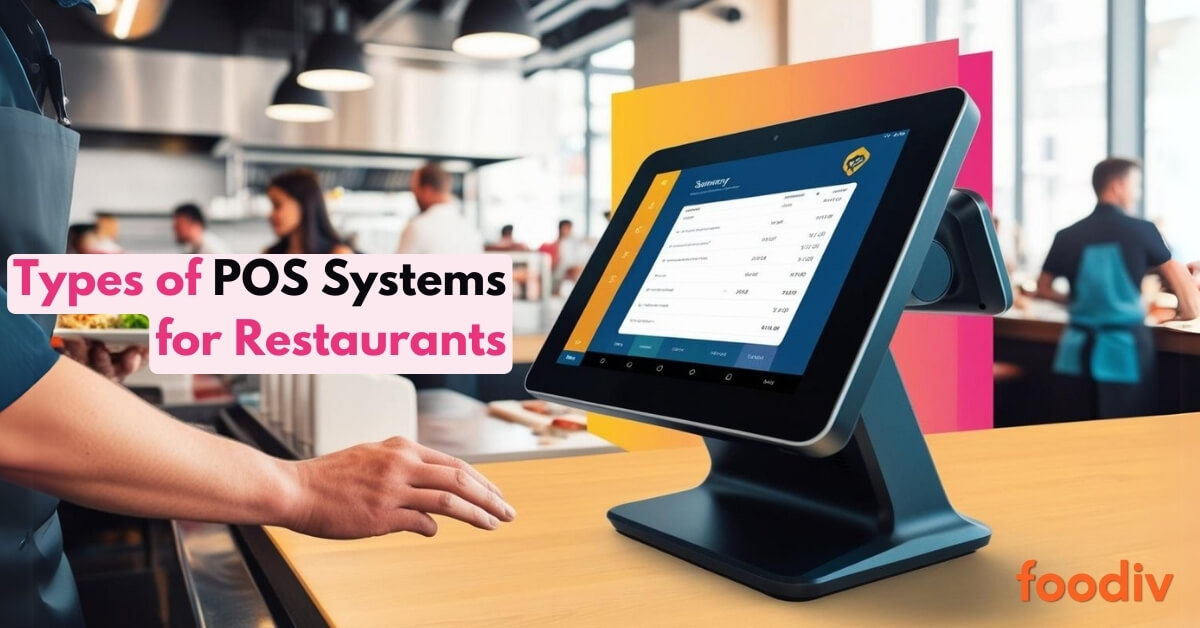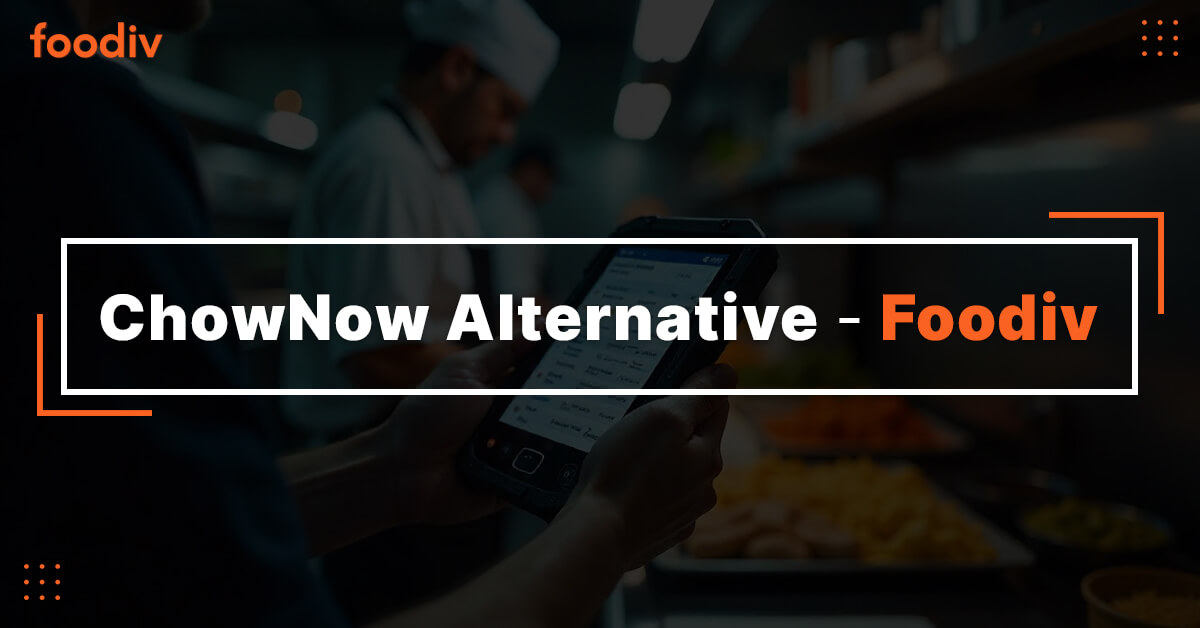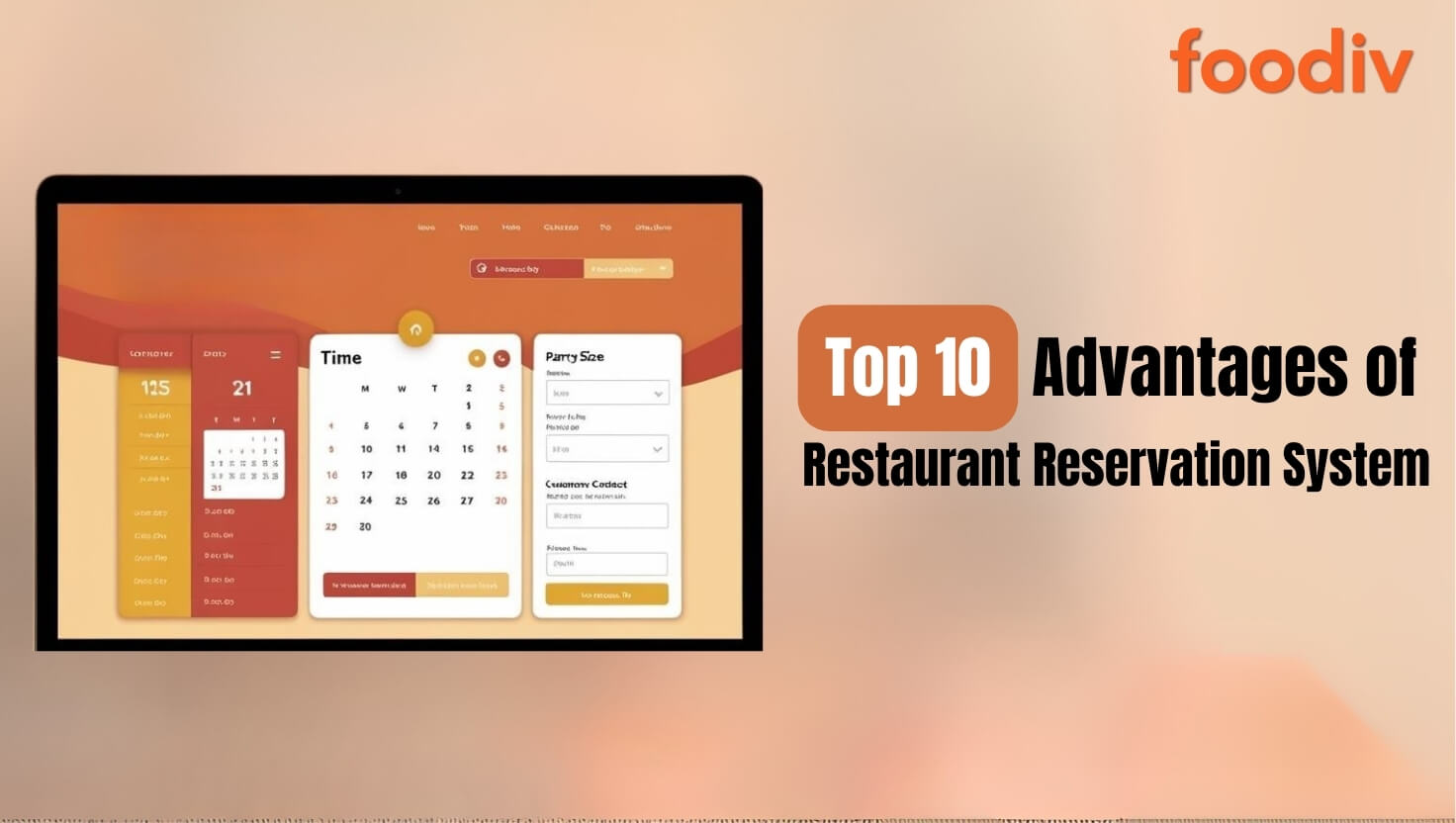 A point-of-sale (POS) system is an essential tool for modern restaurants, improving efficiency and streamlining operations. According to Fortune Business Insights, the global POS market is projected to reach $110.22 billion by 2032, driven by the growing demand for digital transactions and automation in the food industry. Restaurants use POS systems to manage orders, process payments, and track inventory, enhancing customer experience and business performance. Choosing the right POS system is crucial for smooth restaurant operations. This guide explores the different types of POS systems for restaurants, helping food business owners make informed decisions.
A point-of-sale (POS) system is an essential tool for modern restaurants, improving efficiency and streamlining operations. According to Fortune Business Insights, the global POS market is projected to reach $110.22 billion by 2032, driven by the growing demand for digital transactions and automation in the food industry. Restaurants use POS systems to manage orders, process payments, and track inventory, enhancing customer experience and business performance. Choosing the right POS system is crucial for smooth restaurant operations. This guide explores the different types of POS systems for restaurants, helping food business owners make informed decisions.
What is a POS System?
A POS system is a combination of hardware and software that enables restaurants to handle sales transactions efficiently. It serves as the central hub for order processing, payment handling, inventory tracking, and customer management. Unlike traditional cash registers, modern POS systems offer advanced features such as real-time reporting, online ordering integration, and automated inventory management.
Restaurants rely on POS systems to improve operational efficiency, reduce errors, and enhance the dining experience. These systems help streamline order-taking, minimize wait times, and support multiple payment methods, including contactless and mobile payments. Whether running a small cafe or a large fine-dining restaurant, selecting the right POS system is essential for optimizing business operations.
What are the components of a POS system?
A POS system consists of several key components they are:
Hardware
This includes touchscreen terminals for processing orders, cash drawers for secure storage, barcode scanners for quick product entry, receipt printers for generating customer bills, and card readers for accepting debit and credit card payments. Some restaurants also use kitchen display systems (KDS) to send orders directly to the kitchen staff, improving order accuracy and reducing wait times.
Software
The software component controls the entire POS system, managing order processing, payment transactions, sales tracking, and inventory management. Advanced software solutions offer features like real-time analytics, employee performance tracking, and customer relationship management (CRM) tools to enhance business decision-making.
Integrations
Modern POS systems integrate with third-party applications to expand functionality. These include online ordering platforms for takeout and delivery, loyalty programs for customer retention, accounting software for financial tracking and inventory management systems to monitor stock levels in real-time. Seamless integrations help automate tasks, reduce manual errors, and improve overall efficiency.
Types of POS Systems for Restaurants
Selecting the right POS system is essential for restaurant owners looking to improve efficiency and customer service. There are various types of POS systems for restaurants, each designed to meet different operational needs. Below is a detailed breakdown of the most commonly used POS systems in the food industry.
Traditional POS Systems
Traditional POS systems are on-premise, hardware-based solutions commonly used in full-service restaurants, fine dining, and high-volume establishments. These systems store data locally on in-house servers, making them independent of internet connectivity.
They come with fixed terminals, receipt printers, and cash drawers and often integrate with kitchen display systems (KDS) and advanced inventory tracking tools. Since traditional POS systems do not rely on cloud storage, security is stronger, but maintenance requires manual updates and IT support. These systems work best for restaurants that prioritize reliability, speed, and extensive customization options.
Pros
- Reliable, with minimal downtime since it does not rely on the internet.
- Faster transaction processing, ensuring smooth operations during peak hours.
- Secure, as all data is stored on-site, reducing cybersecurity risks.
- Customizable with advanced features such as kitchen display systems and table management.
Cons
- High initial investment in hardware and software licensing.
- Requires physical presence for maintenance, updates, and troubleshooting.
- Limited remote access, makes data management difficult outside the restaurant.
Cloud-Based POS Systems
Cloud-based POS systems are internet-driven solutions that store transactional and operational data in cloud servers. This type of POS system is widely used in quick-service restaurants, multi-location franchises, and small businesses looking for an affordable and scalable system.
With cloud-based POS systems, restaurant owners can access sales reports, monitor inventory, and track employee performance remotely through a web dashboard or mobile app. These systems automatically update software and store backups, ensuring data security without manual intervention. However, since they require constant internet access, restaurants need a stable connection to avoid operational disruptions.
Pros
- Lower initial costs with a subscription-based pricing model.
- Enables remote access to sales, inventory, and employee performance data.
- Automatic software updates and cloud backups enhance security and efficiency.
- Easily integrates with online ordering platforms, delivery services, and loyalty programs.
Cons
- Requires a stable internet connection; downtime can disrupt operations.
- Monthly subscription costs may increase over time.
- Data security depends on the cloud service provider’s encryption and compliance measures.
Mobile POS Systems
Mobile POS systems are tablet or smartphone-based solutions that provide flexibility in order-taking and payment processing. These POS systems are commonly used in food trucks, casual dining restaurants, and outdoor venues, where portability is essential.
With mobile POS systems, servers can take orders directly at the table and send them to the kitchen, improving service efficiency. These systems support contactless payments and often integrate with loyalty programs and digital receipts, enhancing the customer experience. While convenient, mobile POS systems may lack advanced reporting and multi-device synchronization found in larger setups.
Pros
- Portable and convenient, enabling tableside ordering and faster service.
- Cost-effective, as it eliminates the need for bulky hardware.
- Reduces order errors by sending customer requests directly to the kitchen.
- Supports contactless and mobile payment options.
Cons
- Limited processing power compared to full POS terminals.
- Internet dependency may cause disruptions if connectivity is weak.
- May lack advanced reporting and inventory management features.
Self-Service Kiosk POS Systems
Self-service kiosk POS systems are automated ordering terminals that allow customers to place orders, customize meals, and complete payments independently. These POS systems are popular in fast-food chains, high-traffic locations, and quick-service restaurants where speed and efficiency are critical.
Kiosks feature touchscreen displays with digital menus, enabling businesses to increase upselling opportunities and reduce wait times. These systems also provide multi-language support and integrated payment processing, catering to a wider customer base. However, restaurants must ensure regular software updates and maintenance to keep kiosks running smoothly.
Pros
- Reduces wait times by allowing customers to order without staff assistance.
- Enhances order accuracy, minimizing human errors in taking requests.
- Increases sales by promoting upselling and add-ons through digital menus.
- Improves customer experience by providing a fast and seamless ordering process.
Cons
- High upfront costs for kiosk hardware and software.
- Requires regular maintenance and software updates.
- Some customers may prefer human interaction over digital ordering.
Tablet-Based POS Systems
Tablet-based POS systems use iPads or Android tablets as terminals, offering a lightweight and flexible alternative to traditional POS setups. These systems are widely used in cafes, coffee shops, and small restaurants that need a modern yet budget-friendly solution.
Unlike mobile POS systems, tablet-based solutions are fixed at counters or workstations, providing a blend of portability and stability. They often feature inventory tracking, employee management, and sales reporting tools, making them suitable for businesses looking to scale. While they require internet access, many come with offline modes to process transactions during connectivity issues.
Pros
- Affordable compared to traditional POS systems, reducing initial investment.
- User-friendly interface makes training staff easier.
- Can be integrated with kitchen display systems for improved workflow.
- Scalable for multi-location businesses.
Cons
- Limited offline functionality; requires internet for full operations.
- May need additional accessories like receipt printers and barcode scanners.
- Some models may not support complex inventory management.
Restaurant Table Ordering System
Hybrid POS Systems
Hybrid POS systems combine local server reliability with cloud-based remote management. This dual functionality makes them ideal for full-service restaurants, large-scale franchises, and businesses needing both online and offline capabilities.
These POS systems allow restaurants to operate without internet disruptions, ensuring consistent order processing and payment handling. At the same time, owners can remotely monitor sales and inventory data via cloud dashboards. Hybrid POS systems also support third-party integrations, making them a versatile choice for businesses balancing on-site efficiency and digital connectivity.
Pros
- Works offline, ensuring uninterrupted transactions even without internet access.
- Syncs with cloud storage, allowing remote monitoring and reporting.
- Highly customizable for different restaurant business models.
- Reduces risks of data loss with dual storage (local and cloud).
Cons
- More expensive than standard cloud POS systems.
- Requires periodic updates and IT support for maintenance.
- Initial setup can be complex for small businesses.
Online Ordering & Delivery POS Systems
Online ordering and delivery POS systems cater to restaurants focusing on takeout, curbside pickup, and food delivery services. These POS systems directly integrate with third-party delivery platforms, restaurant websites, and mobile apps, ensuring a seamless digital ordering process.
With these POS systems, restaurants can automate order flow from online platforms to kitchen staff, reducing manual entry errors. Some systems also include driver tracking, automated customer notifications, and real-time inventory synchronization. To maximize efficiency, restaurants must ensure that their POS system supports multiple integration channels without delays or technical failures.
Pros
- Automates order processing from online and mobile ordering platforms.
- Reduces manual data entry errors by syncing orders directly to the kitchen.
- Enhances delivery tracking and customer communication.
- Expands revenue opportunities by supporting multiple online sales channels.
Cons
- Third-party delivery platform commissions may reduce profit margins.
- Requires reliable internet connectivity for smooth operations.
- May need additional investment in integration tools and software.
How to Choose the Right POS System for Your Restaurant
Choosing the right POS system depends on various factors, including business size, service type, and operational needs.
Restaurant Type
Full-service restaurants benefit from traditional POS systems, as they offer stability and customization. Small cafes and casual dining spots may prefer tablet-based POS systems for their affordability and ease of use.
Remote Access Needs
Cloud-based POS systems are ideal for restaurant owners who need to manage operations remotely. Hybrid POS systems offer offline reliability while syncing data with the cloud for centralized management.
Online Ordering & Delivery
Restaurants that rely on takeout and delivery services should choose POS systems that integrate seamlessly with third-party delivery platforms to automate order processing.
Customer Experience
Fast-food chains and quick-service restaurants can improve efficiency with self-service kiosk POS systems. For full-service dining, mobile POS systems enable tableside ordering, reducing wait times.
Budget & Scalability
Restaurants should evaluate the upfront costs, subscription fees, and long-term savings of different POS systems. Choosing a scalable solution ensures that the POS can grow with the business.
Selecting the right POS system streamlines operations, enhances efficiency, and improves customer satisfaction.
Factors for Choosing the Best Type of Restaurant POS System
Choosing the right POS system requires careful evaluation of features that impact restaurant performance. Below are the key factors to consider:
Ease of Use
A POS system should have an intuitive interface that allows staff to take orders and process payments quickly. Complicated systems can slow down service and require extensive training.
Integration Capabilities
The POS system should connect seamlessly with online ordering platforms, payment processors, inventory management tools, and customer relationship management (CRM) software. Proper integration ensures a smooth workflow and data synchronization.
Cost and ROI
Consider both initial setup costs and long-term expenses, such as subscription fees or maintenance charges. A well-optimized POS system improves efficiency, reduces waste, and increases revenue over time.
Customer Experience
A fast and efficient POS system reduces wait times, minimizes order errors, and supports multiple payment options, enhancing overall customer satisfaction.
Security and Compliance
Data protection is crucial in any restaurant business. A reliable POS system should include secure payment processing, encryption, and compliance with industry standards to prevent fraud and data breaches.
By analyzing these factors, restaurant owners can invest in a POS system that improves operations and supports business growth.
Conclusion
Choosing the right POS system is crucial for optimizing restaurant operations, improving efficiency, and enhancing customer satisfaction. Different types of POS systems for restaurants serve various business needs, from traditional setups to modern cloud-based and mobile solutions. Evaluating key factors such as ease of use, integration capabilities, cost, and security helps in making an informed decision.
At Foodiv, we offer a Restaurant POS System designed to streamline your operations. Our end-to-end solutions provide seamless integration, secure transactions, and advanced features tailored to your restaurant’s needs. Contact us today to upgrade your restaurant with a powerful POS system.








 A point-of-sale (POS) system is an essential tool for modern restaurants, improving efficiency and streamlining operations. According to
A point-of-sale (POS) system is an essential tool for modern restaurants, improving efficiency and streamlining operations. According to 

